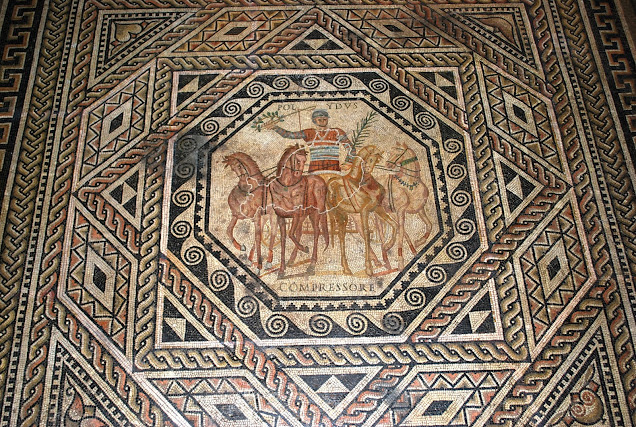Amphitheatre of Calleva Atrebatum
A short trip out of London, north of Hampshire in 2002, brought me by train into the British countrysite. During a stroll I encountered the Roman excavations at Silchester, or Calleva Atrebatum. Originally, a settlement of the Atrebates - or as the Celtic name says 'the town in the woods of the Atrabates' - it became Romanised after the Roman invasion AD 43.
There is no certain evidence available to suggest that Calleva Atrebatum ever attained the status of a municipium or chartered town, where the citizens had voting rights, but this may have been granted as early as the time of creation of the civitas. It is difficult to estimate the population of the town, but if suburbs are excluded and calculations confined to the known buildings within the Roman defences, a minimum figure of about 1,200 is reached. Without written evidence there can be neither certainty about numbers, nor how they fluctuated with time, but figures as high as 7,500 and as low as 600-750 have also been estimated. For further reading: A Guide to Silchester. The Roman Town of Calleva Atrebatum, by Michael Fulford. A nice youtube movie you can find here!
It is therefore quite extraordinary, to find an amphitheater, that provided space for between 4,500 and 9,000 spectators. It was probably first built between 50 and 70 AD at the eastern edge of the town. The arena now has an elliptical plan, with two opposing entrances on the longer, north-south axis and two small rooms recessed into the seating bank on the east-west axis. It measured about 45 by 39 metres. No evidence survives of the sort of activities which took place here, but gladiatorial combat and shows using wild beasts were popular, but expensive, forms of entertainment elswere in the Roman empire. Blood sports using bulls, dogs and bears are possibilities at Silchester. Public execution also took place in amphitheaters, so probably also over here.
William Stukeley, poet and freemason, first identified the amphitheater in 1724. Stukeley also pioneered the archeological investigation of the prehistoric monuments of Stonehenge and Avebury and is regarded as one of the 'New Druids'. It does not appear to have been excavated before 1979. Unfortunately, no theater has been discovered at Calleva.
There is no certain evidence available to suggest that Calleva Atrebatum ever attained the status of a municipium or chartered town, where the citizens had voting rights, but this may have been granted as early as the time of creation of the civitas. It is difficult to estimate the population of the town, but if suburbs are excluded and calculations confined to the known buildings within the Roman defences, a minimum figure of about 1,200 is reached. Without written evidence there can be neither certainty about numbers, nor how they fluctuated with time, but figures as high as 7,500 and as low as 600-750 have also been estimated. For further reading: A Guide to Silchester. The Roman Town of Calleva Atrebatum, by Michael Fulford. A nice youtube movie you can find here!
It is therefore quite extraordinary, to find an amphitheater, that provided space for between 4,500 and 9,000 spectators. It was probably first built between 50 and 70 AD at the eastern edge of the town. The arena now has an elliptical plan, with two opposing entrances on the longer, north-south axis and two small rooms recessed into the seating bank on the east-west axis. It measured about 45 by 39 metres. No evidence survives of the sort of activities which took place here, but gladiatorial combat and shows using wild beasts were popular, but expensive, forms of entertainment elswere in the Roman empire. Blood sports using bulls, dogs and bears are possibilities at Silchester. Public execution also took place in amphitheaters, so probably also over here.
William Stukeley, poet and freemason, first identified the amphitheater in 1724. Stukeley also pioneered the archeological investigation of the prehistoric monuments of Stonehenge and Avebury and is regarded as one of the 'New Druids'. It does not appear to have been excavated before 1979. Unfortunately, no theater has been discovered at Calleva.
Standing in the arena, I can hardly imagine that this was focal point for so much entertainment and so many emotions.
More detailed information you can find in: 'Roman amphitheaters in England and Wales', by Roy Wilding, Chester 2005.
More detailed information you can find in: 'Roman amphitheaters in England and Wales', by Roy Wilding, Chester 2005.




Reacties
Een reactie posten